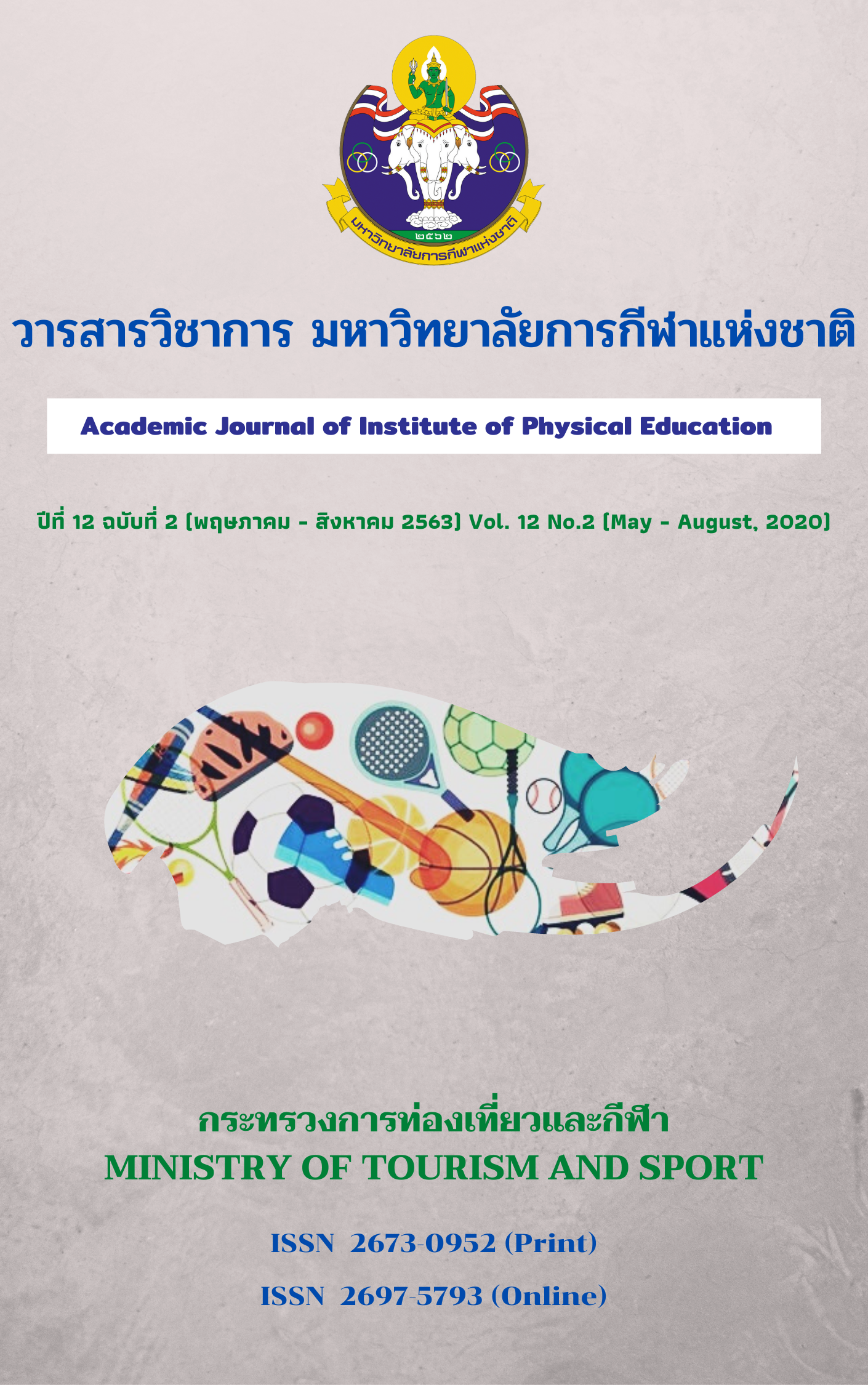THE MANAGEMENT APPROACH OF SPORT FOR ALL BY SOCIAL NETWORKING
Main Article Content
Abstract
The objectives of this study were to research on duties and roles of the organizations that were associated with sport for all and create the development process with social networking. The data of the study were collected from questionnaire on a sample group of members from 179 sport clubs, in-depth interviewing from 9 experts, and focus group with 10 sport for all experts working on social networking and sport management. The research tools were questionnaire which has been guaranteed by Cronbach’s Alpha Coefficient with 0.85 reliability index and semi-structured interview which assessed by index of item objective congruence (IOC). The results were found as follows:
- 1. The duties and roles of organizations associated with sport for all are to maintain the frequency and duration of cooperation. An adequate time to organize and promote sport and fitness regularly is the main factor for the sustainable development of sport for all.
- 2. The process to the development of sport for all is driven by a proper social networking which consists of 3 parts: the governmental organization, private organization and public organization. These organizations are gathered together informally according to the objective of the activity and the voluntary and staff system. However, the private organization is appointed as the main driver supported by the government while the public organization main role is to execute and determine the direction of the process in correspondent with government policy using combination of formal and informal working mechanism.
The conclusion and suggestion to the acknowledgement of factors that are associated with the drive that forms developing methods and cooperation among social networking for fitness development and sport for all.
Article Details
The published article is a copyright of the Academic Journal of Thailand National Sports University. The passage appeared in each article in this academic journal is a perspective of each author which is not related to the journal. Each author is required to be responsible for all components of his/her own article. If there are any mistakes, each author must be responsible for those mistakes on his/her own.
References
Boissevain, J. (1974). Friend of Friend: Networks, Manipulators and Coalitions. Oxford: Basil Blackweel.
Faculty of Sports Science, Kasetsart University. (2015). Evaluation Project of National Development Plan 5 (2012-2016) Half term plan. Copied documents.
Hamer, M. and Y. Chida. (2009). “Physical activity and risk of neurodegenerative disease: A systematic review of prospective evidence.” Psychological Medicine, 39, 3-11.
Kasem Nakornkhet. (2011). Social Network Theory. Nonthaburi: Health Alliance Project, Ministry of Public Health.
Khaw, K. T., N. Wareham, S. Bingham, A. Welch, R. Luben and N. Day. (2008). Combined impact of health behaviours and mortality in men and women: The EPIC-Norfolk Prospective Popoulation Study”. Obstetrical & Gynecological Survey, 63, 376-377.
Ornish, D., J. Lin, J. L. Daubenmier, G. Weidner, E. Epel, C. Kemp and E.H. Blackburn. (2008). Increased telomerase activity and comprehensive lifestyle changes: A pilot study. The Lancet Oncology, 9, 1048-1057.
Parichart Sathapitanon and Chaiwat Thirapan. (2003). Communication with Social Network. Bangkok: Local Development Institute.
Phra Maha Sutit Apakro. (2005). Network: Nature, knowledge and Management. Bangkok: Learning and empowerment for healthy community project.
Scheuing, E. (1994). The power of partnering. New York: Amacom.
Sui, X., J. Laditka, T. Church, J. Hardin, N. Chase, K. Davis and S. Blair. (2009). Prospective study of cardiorespiratory fitness and depressive symptoms in women and men. Journal of Psychiatric Research, 43, 546-552.
Wasserman, S. K. Faust. (1999). Social Network Analysis: Method and Applications. Cambridge: Cambridge University Press.
Weerasak Krueathep. (2007). Network: Innovation of Work of Local Administrative Organizations. Bangkok: CNO design.


